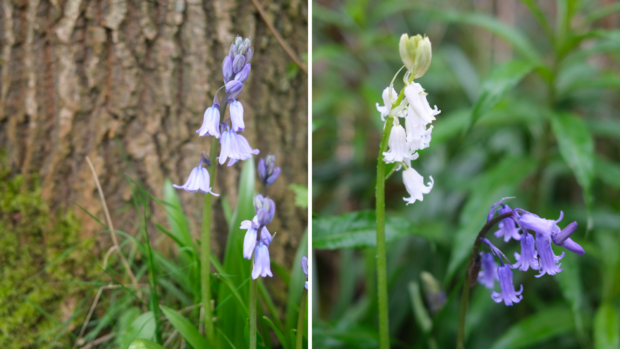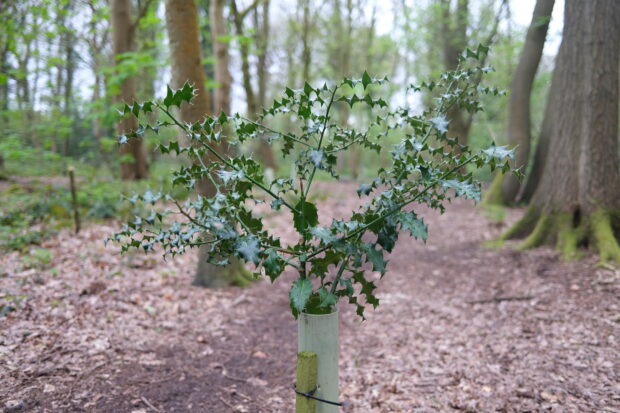Introducing 'Into the Woods' our new blog series where staff members share their adventures in England's woodlands. Join us every month as we explore the woodlands we love and uncover their beauty, wildlife, and hidden treasures.
 Charlie Young, Forestry Commission's Content and Digital Manager, explores Marbury Country Park’s woodlands to find native bluebells, highlighting how to spot the species and how to explore responsibly.
Charlie Young, Forestry Commission's Content and Digital Manager, explores Marbury Country Park’s woodlands to find native bluebells, highlighting how to spot the species and how to explore responsibly.
Bluebells spend most of the year nestled underground waiting to bloom, favouring the undisturbed soil of well-established and ancient woodlands. But come April and May, they carpet our woodland floors with their recognisable deep violet-blue bells and drooping stems.
They are one of the last spring flowers to appear, making the most of the sunlight before the woodland canopy closes up. Although their flowering period is brief, lasting just a few weeks, they spend their short stay soaking up energy to sustain themselves through the winter months.

Marbury Country Park lies in the heart of Northwich Community Woodlands and is part of the Mersey Forest. It was once a large private estate, still noticeable from its lime lined avenues and arboretum, planted in the Victorian era. Today, its network of public footpaths connect woodland, meadows, streams and Budworth Mere, providing a rich habitat for a variety of wildlife.
Spot the difference
Walking straight to Big Wood, it isn't long until you’re greeted with a sea of bluebells. You can spot native bluebells by looking out for their narrow leaves, drooping stems, creamy-white pollen and on one side, their recognisable vibrant violet-blue bell flowers with tips that curl back.

Moving through Big Wood, through to Forge Wood, you’ll continue to see floors scattered with bluebells. But despite the name, bluebells aren’t always the recognisable deep violet-blue that we’ve come to love and can sometimes be white or pink; Spanish or hybrid bluebells can be a much paler violet hue.
Originally introduced as a garden plant, the Spanish bluebell has escaped the garden fences and can now be found alongside our native bluebells in woodlands, in fields, along hedgerows and the roadside. With their upright stems, blue pollen, and all-around flowers with spreading open tips, Spanish bluebells can be a threat to our native bluebell, often outcompeting it for light and space. The mixing of Spanish and native bluebells can produce a range of characteristics, which can dilute the unique features of our native flower over time.
Still struggling to spot the difference? Try smelling the flower! Native bluebells give off a sweet scent while Spanish bluebells have no smell.

Careful where you step
UK woodlands are home to over half of the global population of our native bluebells. They are really slow to colonise new areas and so our population can’t react quickly to environmental change, like extreme weather, or increased footfall. Damage to their leaves can impede their ability to photosynthesise, reducing their capacity to seed and flower.
Walking off track and through bluebell carpets can create narrow tracks for others to follow. These quickly widen with repeated foot traffic, leading to soil compaction that fragments the carpets. While we’re exploring woodland, it’s important to stick to designated woodland paths and follow signage to help protect bluebells, as well as other habitats.
Their slow colonisation of new areas means that bluebells are a wonderful indicator of landscape history. Carpets of bluebells sometimes remain in the landscape decades and even centuries after their original canopy of woodland trees have disappeared. And bluebells hiding under hedgerows hint at a lost landscape that was both wilder and more wooded.
Where to find a bluebell woodland
Before the warmth of spring comes in and the canopy closes, if you would like to capture a glimpse of bluebells this spring, find your local woodland:
- Forestry England’s top walks
- Wildlife Trust’s where to see bluebells
- Woodland Trust’s best bluebell woods
- National Trust’s best place to see bluebells
If you don’t make bluebell season, like many woodlands Marbury Country Park has a rich heritage and its size and diversity in habitats make it a unique visit. From ancient woodland to young trees, lakes to reedbeds to meadows and picnic areas, there’s plenty to enjoy.

New 'Into the woods' posts will be uploaded every month so subscribe to receive updates by email and follow us on X and LinkedIn.


